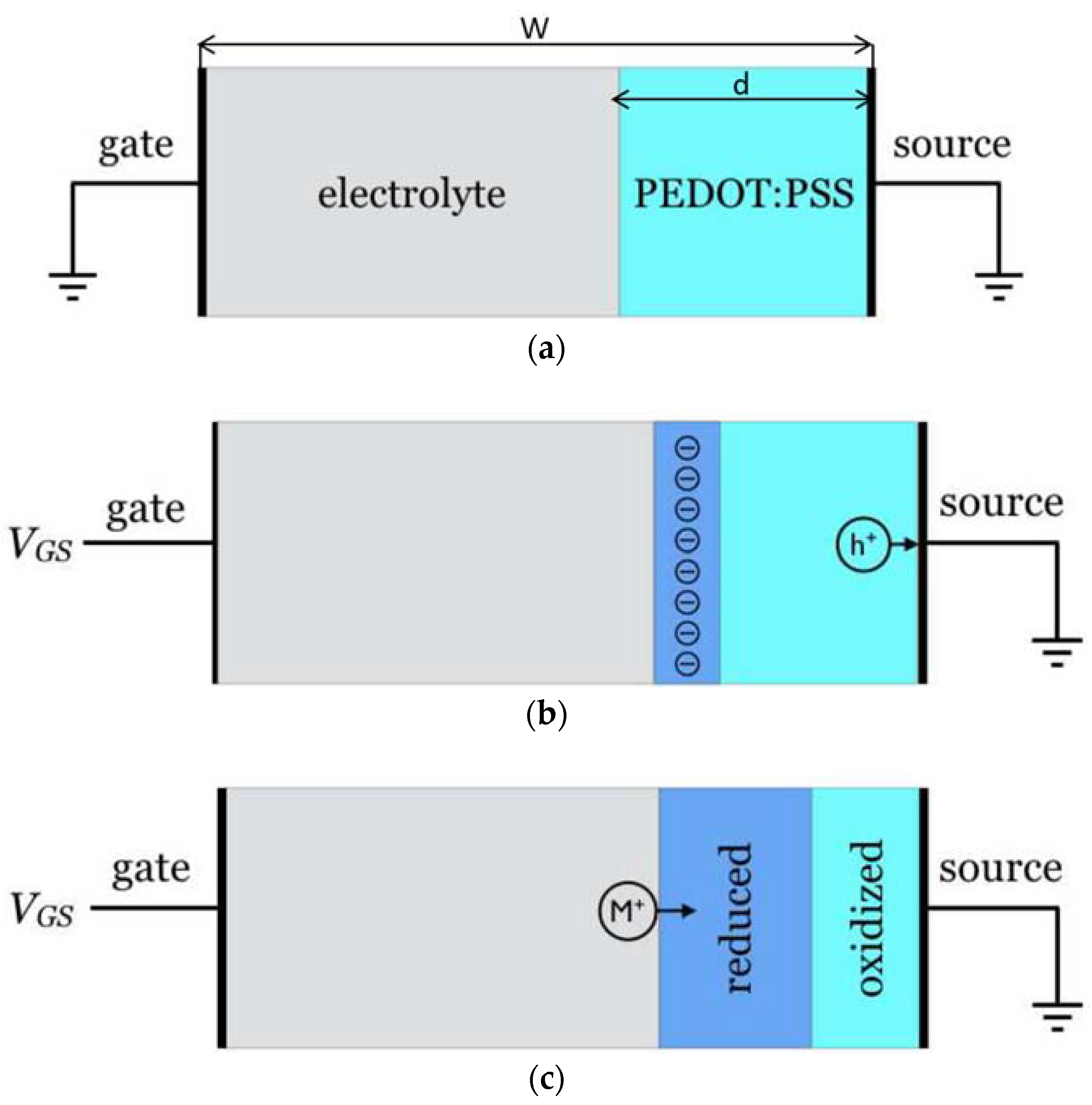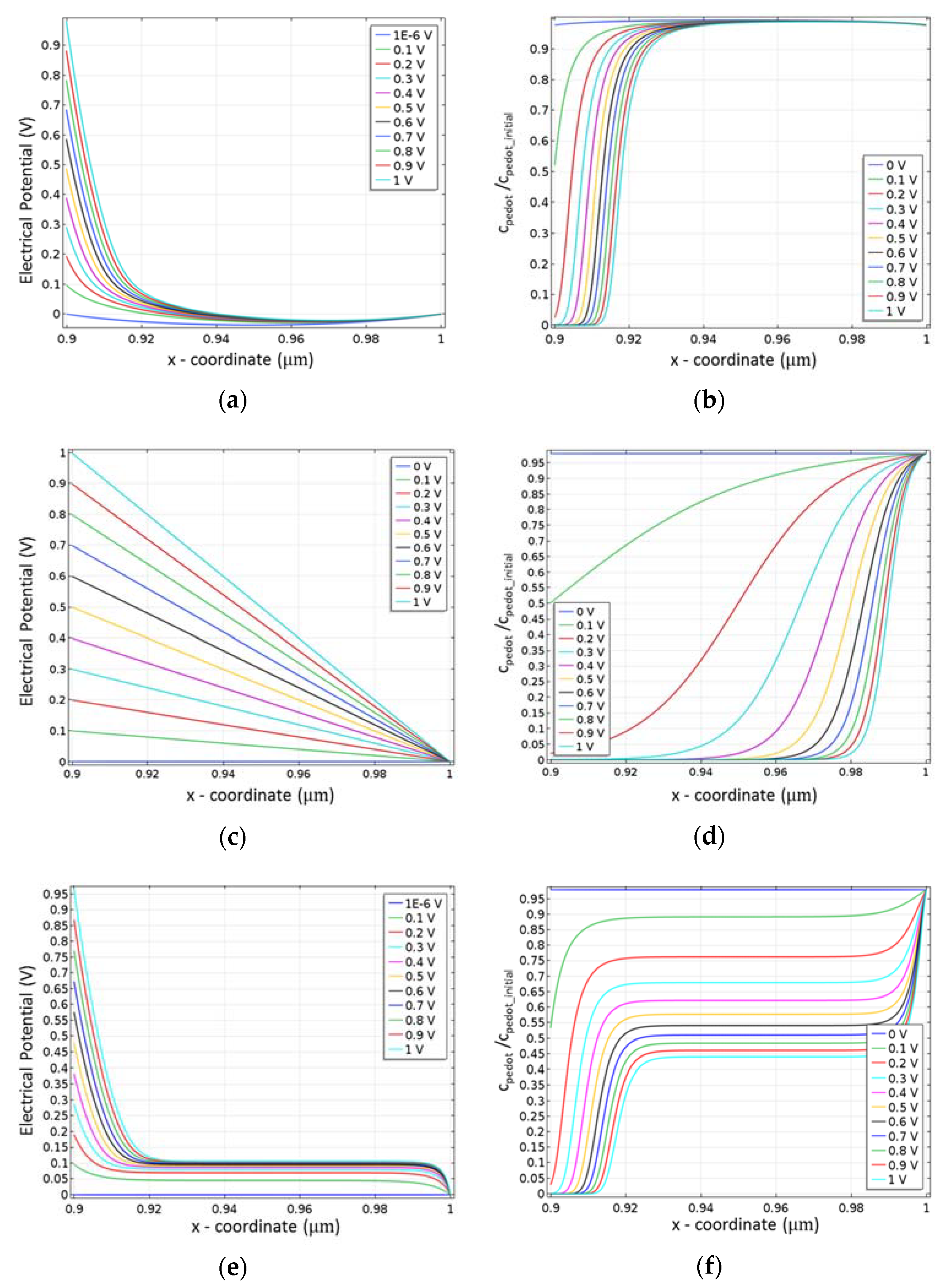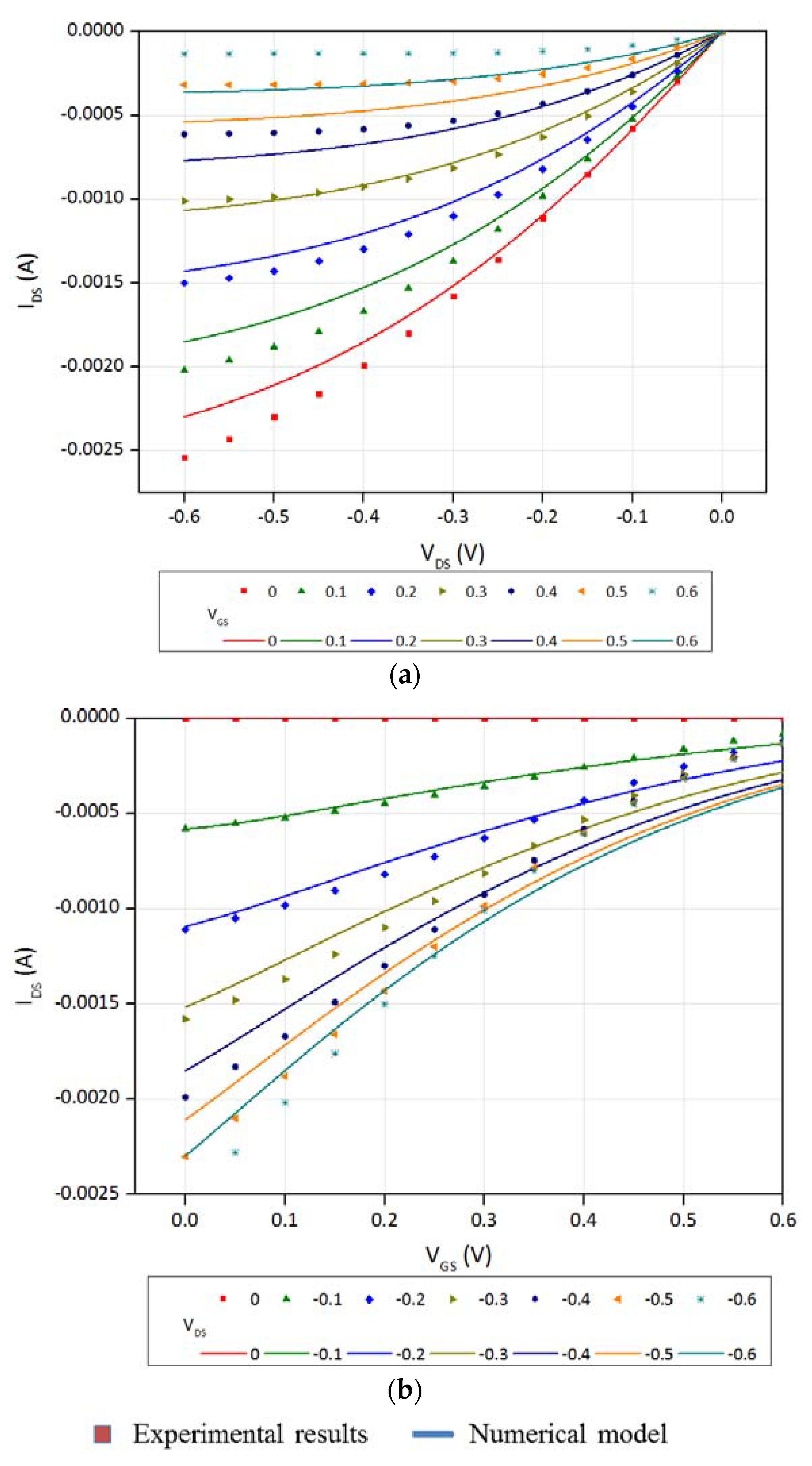Numerical Modeling of an Organic Electrochemical Transistor
Abstract
:1. Introduction
2. Materials and Methods
3. Results and Discussion
3.1. Model Description
3.1.1. Physical Description of the Doping–Dedoping Process Occurred in the Channel of an OECT
3.1.2. Basic Equations
3.2. Model Implementation and Experimental Results
3.2.1. Steady-State Potential and Hole Density Profile
- An ionic layer with 100 mM of NaCl solution. The thickness of the layer is W − d = 900 nm.
- An electronically conductive PEDOT:PSS layer. The initial density of PEDOT+ (mobile holes) equals that of PSS− (immobile anions) was set to 1018 cm−3 which is probably lower than the actual density in real devices. This choice of initial hole density was made on purpose to make clearer the correlation between hole density inside conductive polymer and potential applied. The thickness of the conductive polymer layer is d = 100 nm. This thickness was chosen in reference to actual OECT biosensors.
- In the case of no ion penetration inside the conductive polymer (Figure 2a,b) the main potential drop and reduction of PEDOT+ concentration occurs at the interface with the electrolyte. The reduced part of PEDOT:PSS layer widens when the applied potential increases. Nevertheless, even at a relatively high applied potential (1 V), only a small part of the channel is reduced. Due to such a small influence of the applied potential on PEDOT+ concentration this model is not appropriate to describe both the moving front experiment and OECT behavior.
- In the case of Local electro-neutrality, the drop of the potential is linear along the thickness of the channel, which perfectly fits the expected zero electric field gradient profile (Figure 2c). Figure 2d represents the concentration profile of PEDOT+. As expected, this concentration decreases with the applied source-gate voltage, and the shape of the decrease highly resembles the moving front experiment profile [30]. However, it must be pointed out that we are here dealing with a steady state model, so the front does not move with time, but instead with the applied gate-source voltage. To the best of our knowledge, no experimental data in the literature would confirm or reject such a behavior.
- In the case of Global electro-neutrality (Figure 2e,f) the main potential drop occurs at the very interface between the electrolyte and conductive polymer. An additional potential drop occurs near an interface between the conductive polymer and Source electrode. In between, that is, in most of the conductive layer, the potential profile is flat and saturates at around 0.1 V for all applied Gate-Source voltages from 0 V to 1 V.
3.2.2. Experimental Check
3.2.3. Output and Transfer Curves of the OECT
4. Conclusions
Author Contributions
Funding
Acknowledgments
Conflicts of Interest
References
- White, H.S.; Kittlesen, G.P.; Wrighton, M.S. Chemical Derivatization of an Array of Three Gold Microelectrodes with Polypyrrole: Fabrication of a Molecule-Based Transistor; Department of Chemistry, Massachusetts Institute of Technology: Cambridge, MA, USA, 1984. [Google Scholar]
- Nilsson, D.; Chen, M.; Kugler, T.; Remonen, T.; Armgarth, M.; Berggren, M. Bi-stable and dynamic current modulation in electrochemical organic transistors. Adv. Mater. 2002, 14, 51–54. [Google Scholar] [CrossRef]
- Khodagholy, D.; Rivnay, J.; Sessolo, M.; Gurfinkel, M.; Leleux, P.; Jimison, L.H.; Stavrinidou, E.; Herve, T.; Sanaur, S.; Owens, R.M. High transconductance organic electrochemical transistors. Nat. Commun. 2013, 4, 2133. [Google Scholar] [CrossRef] [PubMed]
- Nilsson, D.; Robinson, N.; Berggren, M.; Forchheimer, R. Electrochemical logic circuits. Adv. Mater. 2005, 17, 353–358. [Google Scholar] [CrossRef]
- Khodagholy, D.; Doublet, T.; Quilichini, P.; Gurfinkel, M.; Leleux, P.; Ghestem, A.; Ismailova, E.; Hervé, T.; Sanaur, S.; Bernard, C. In vivo recordings of brain activity using organic transistors. Nat. Commun. 2013, 4, 1575. [Google Scholar] [CrossRef] [PubMed]
- Lin, P.; Yan, F. Organic thin-film transistors for chemical and biological sensing. Adv. Mater. 2012, 24, 34–51. [Google Scholar] [CrossRef] [PubMed]
- Zhu, Z.-T.; Mabeck, J.T.; Zhu, C.; Cady, N.C.; Batt, C.A.; Malliaras, G.G. A simple poly (3,4-ethylene dioxythiophene)/poly (styrene sulfonic acid) transistor for glucose sensing at neutral pH. Chem. Commun. 2004, 13, 1556–1557. [Google Scholar] [CrossRef] [PubMed]
- Macaya, D.J.; Nikolou, M.; Takamatsu, S.; Mabeck, J.T.; Owens, R.M.; Malliaras, G.G. Simple glucose sensors with micromolar sensitivity based on organic electrochemical transistors. Sens. Actuators B Chem. 2007, 123, 374–378. [Google Scholar] [CrossRef]
- Bernards, D.A.; Macaya, D.J.; Nikolou, M.; DeFranco, J.A.; Takamatsu, S.; Malliaras, G.G. Enzymatic sensing with organic electrochemical transistors. J. Mater. Chem. 2008, 18, 116–120. [Google Scholar] [CrossRef]
- Jia, W.; Bandodkar, A.J.; Valdés-Ramírez, G.; Windmiller, J.R.; Yang, Z.; Ramírez, J.; Chan, G.; Wang, J. Electrochemical tattoo biosensors for real-time noninvasive lactate monitoring in human perspiration. Anal. Chem. 2013, 85, 6553–6560. [Google Scholar] [CrossRef] [PubMed]
- Tarabella, G.; Balducci, A.G.; Coppedè, N.; Marasso, S.; D’Angelo, P.; Barbieri, S.; Cocuzza, M.; Colombo, P.; Sonvico, F.; Mosca, R. Liposome sensing and monitoring by organic electrochemical transistors integrated in microfluidics. Biochim. Biophys. Acta 2013, 1830, 4374–4380. [Google Scholar] [CrossRef] [PubMed]
- Tang, H.; Lin, P.; Chan, H.L.; Yan, F. Highly sensitive dopamine biosensors based on organic electrochemical transistors. Biosens. Bioelectron. 2011, 26, 4559–4563. [Google Scholar] [CrossRef] [PubMed]
- Lin, P.; Luo, X.; Hsing, I.; Yan, F. Organic electrochemical transistors integrated in flexible microfluidic systems and used for label-free DNA sensing. Adv. Mater. 2011, 23, 4035–4040. [Google Scholar] [CrossRef] [PubMed]
- He, R.-X.; Zhang, M.; Tan, F.; Leung, P.H.; Zhao, X.-Z.; Chan, H.L.; Yang, M.; Yan, F. Detection of bacteria with organic electrochemical transistors. J. Mater. Chem. 2012, 22, 22072–22076. [Google Scholar] [CrossRef]
- Macchia, E.; Romele, P.; Manoli, K.; Ghittorelli, M.; Magliulo, M.; Kovàcs-Vajna, Z.M.; Torricelli, F.; Torsi, L. Ultra-sensitive protein detection with organic electrochemical transistors printed on plastic substrate. Flex. Print. Electron. 2018, 3, 034002. [Google Scholar] [CrossRef]
- Rivnay, J.; Inal, S.; Salleo, A.; Owens, R.M.; Berggren, M.; Malliaras, G.G. Organic electrochemical transistors. Nat. Rev. Mater. 2018, 3, 17086. [Google Scholar] [CrossRef]
- Somani, P.R.; Radhakrishnan, S. Electrochromic materials and devices: Present and future. Mater. Chem. Phys. 2003, 77, 117–133. [Google Scholar] [CrossRef]
- Kawahara, J.; Ersman, P.A.; Engquist, I.; Berggren, M. Improving the color switch contrast in PEDOT: PSS-based electrochromic displays. Org. Electron. 2012, 13, 469–474. [Google Scholar] [CrossRef]
- Tezuka, Y.; Aoki, K. Direct demonstration of the propagation theory of a conductive zone in a polypyrrole film by observing temporal and spatial variations of potentials at addressable microband array electrodes. J. Electroanal. Chem. Interfacial Electrochem. 1989, 273, 161–168. [Google Scholar] [CrossRef]
- Lacroix, J.; Fraoua, K.; Lacaze, P. Moving front phenomena in the switching of conductive polymers. J. Electroanal. Chem. 1998, 444, 83–93. [Google Scholar] [CrossRef]
- Miomandre, F.; Bussac, M.; Vieil, E.; Zuppiroli, L. Monte-Carlo simulation of linear sweep voltammograms during redox switching of conducting polymers. Electrochim. Acta 1999, 44, 2019–2024. [Google Scholar] [CrossRef]
- Warren, M.; Madden, J. Electrochemical switching of conducting polymers: A variable resistance transmission line model. J. Electroanal. Chem. 2006, 590, 76–81. [Google Scholar] [CrossRef]
- Stavrinidou, E.; Leleux, P.; Rajaona, H.; Khodagholy, D.; Rivnay, J.; Lindau, M.; Sanaur, S.; Malliaras, G.G. Direct measurement of ion mobility in a conducting polymer. Adv. Mater. 2013, 25, 4488–4493. [Google Scholar] [CrossRef] [PubMed]
- Prigodin, V.; Hsu, F.; Kim, Y.; Park, J.; Waldmann, O.; Epstein, A. Electric field control of charge transport in doped polymers. Synth. Met. 2005, 153, 157–160. [Google Scholar] [CrossRef]
- Robinson, N.D.; Svensson, P.-O.; Nilsson, D.; Berggren, M. On the current saturation observed in electrochemical polymer transistors. J. Electrochem. Soc. 2006, 153, H39–H44. [Google Scholar] [CrossRef]
- Volkov, A.V.; Wijeratne, K.; Mitraka, E.; Ail, U.; Zhao, D.; Tybrandt, K.; Andreasen, J.W.; Berggren, M.; Crispin, X.; Zozoulenko, I.V. Understanding the capacitance of PEDOT: PSS. Adv. Funct. Mater. 2017, 27, 1700329. [Google Scholar] [CrossRef]
- Tybrandt, K.; Zozoulenko, I.V.; Berggren, M. Chemical potential-electric double layer coupling in conjugated polymer-polyelectrolyte blends. Sci. Adv. 2017, 3, eaao3659. [Google Scholar] [CrossRef] [PubMed]
- Bernards, D.A.; Malliaras, G.G. Steady-state and transient behavior of organic electrochemical transistors. Adv. Funct. Mater. 2007, 17, 3538–3544. [Google Scholar] [CrossRef]
- Yaghmazadeh, O.; Cicoira, F.; Bernards, D.A.; Yang, S.Y.; Bonnassieux, Y.; Malliaras, G.G. Optimization of Organic Electrochemical Transistors for Sensor Applications. J. Polym. Sci. Part B Polym. Phys. 2011, 49, 34–39. [Google Scholar] [CrossRef]
- Stavrinidou, E.; Leleux, P.; Rajaona, H.; Fiocchi, M.; Sanaur, S.; Malliaras, G.G. A simple model for ion injection and transport in conducting polymers. J. Appl. Phys. 2013, 113, 67. [Google Scholar] [CrossRef]
- Modarresi, M.; Franco-Gonzalez, J.F.; Zozoulenko, I.V. Morphology and Ion Diffusion in PEDOT: Tos. A Coarse Grained Molecular Dynamics Simulation. Phys. Chem. Chem. Phys. 2018. [Google Scholar] [CrossRef] [PubMed]
- Sze, S.M.; Ng, K.K. Physics of Semiconductor Devices; John Wiley & Sons: New York, NY, USA, 2006. [Google Scholar]







| Unit | Value |
|---|---|
| T, K | 300 |
| εr | 4 |
| c0, cm−3 | 1.37 × 1019 |
| σmax, S/m | 9892 |
| d, nm | 506 |
| L, μm | 69.65 |
| W, µm | 57.65 |
© 2018 by the authors. Licensee MDPI, Basel, Switzerland. This article is an open access article distributed under the terms and conditions of the Creative Commons Attribution (CC BY) license (http://creativecommons.org/licenses/by/4.0/).
Share and Cite
Shirinskaya, A.; Horowitz, G.; Rivnay, J.; Malliaras, G.G.; Bonnassieux, Y. Numerical Modeling of an Organic Electrochemical Transistor. Biosensors 2018, 8, 103. https://0-doi-org.brum.beds.ac.uk/10.3390/bios8040103
Shirinskaya A, Horowitz G, Rivnay J, Malliaras GG, Bonnassieux Y. Numerical Modeling of an Organic Electrochemical Transistor. Biosensors. 2018; 8(4):103. https://0-doi-org.brum.beds.ac.uk/10.3390/bios8040103
Chicago/Turabian StyleShirinskaya, Anna, Gilles Horowitz, Jonathan Rivnay, George G. Malliaras, and Yvan Bonnassieux. 2018. "Numerical Modeling of an Organic Electrochemical Transistor" Biosensors 8, no. 4: 103. https://0-doi-org.brum.beds.ac.uk/10.3390/bios8040103





